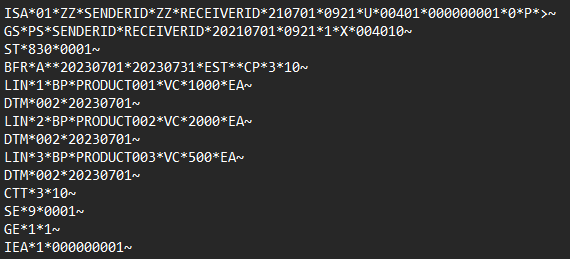How to use EDI 830
To use EDI 830, you need an EDI solution that supports the transaction. Many organizations leverage specialized software to convert EDI messages into a format compatible with their internal systems. These EDI tools facilitate seamless data exchange and integration with existing workflows.
You should consider the following points to use EDI 830 effectively:
- Implement an EDI Solution: Choose an EDI software or service provider that supports the EDI 830 transaction. These solutions are designed to handle the complexities of EDI messaging and ensure smooth integration with your existing systems. Look for a tool that offers comprehensive features such as mapping, data validation, and communication protocols.
- Set up Trading Partner Agreements: Establish trading partner agreements with your suppliers or customers to define the specific EDI requirements and communication protocols. This includes agreeing on the version of the EDI standard to be used (e.g., X12, EDIFACT), as well as the transmission methods (e.g., AS2, FTP, VAN).
- Map EDI 830 to Internal Systems: Work with your EDI solution provider to map the data elements in the EDI 830 message to the corresponding fields in your internal systems. These could be your enterprise resource planning (ERP) or warehouse management systems (WMS). This mapping ensures that the information received through the EDI 830 is correctly interpreted and processed by your systems.
- Test and Validate: Conduct thorough testing and validation of your EDI implementation before fully deploying it. Exchange test EDI 830 messages with your trading partners to verify that you can transmit, receive, and integrate the data accurately.
EDI 830 Transaction Example
Let’s take a hypothetical scenario to understand how an EDI 830 transaction takes place.
Consider a buyer generates an EDI 850 (Purchase Order) and sends it to its trading partner/supplier. This document contains information about the requested products, quantities, pricing, and delivery requirements.
Upon receiving the EDI 850, the supplier generates and transmits an EDI 855 (Purchase Order Acknowledgment) to the buyer. This document confirms the acceptance or rejection of the purchase order and provides details such as order confirmation numbers and requested shipment dates.
Once the purchase order is acknowledged, the buyer sends an EDI 830 to its supplier. The EDI 830 provides detailed production and delivery schedules for the items listed in the purchase order.
As the actual shipment dates approach, the buyer may also choose to send an EDI 862 to its supplier. The EDI 862 communicates specific shipping requirements and instructions for individual shipments.
Throughout this example scenario, the trading partners may also exchange additional EDI documents based on their specific business requirements. These can include an EDI 860 (Purchase Order Change Request) if any modifications are needed to the original purchase order, or an EDI 997 (Functional Acknowledgment) to confirm the receipt and processing of each EDI document.
Benefits of EDI 830
Implementing EDI 830 brings several benefits to trading partners:
- Enhanced Efficiency: By automating the exchange of planning and release schedules, EDI 830 eliminates manual processes, reducing errors and accelerating the supply chain.
- Improved Collaboration: EDI 830 enables real-time sharing of accurate and up-to-date information between buyers and suppliers, fostering better collaboration and alignment in production, inventory, and logistics planning.
- Reduced Costs: By optimizing supply chain processes, EDI 830 helps reduce lead times, inventory carrying costs, and manual data entry expenses.
How EDIConnect Helps
Effective communication and collaboration are vital for success in supply chain management. With the right EDI solution, you can exchange accurate and detailed production and delivery schedules electronically with your trading partners.
EDIConnect is a comprehensive EDI software solution that offers robust support for the EDI 830 transaction and various other EDI transactions. EDIConnect can handle transaction sets in X12 and EDIFACT formats. This flexibility enables businesses to easily exchange EDI documents with their trading partners in a compliant manner. With its intuitive interface and extensive mapping capabilities, EDIConnect simplifies the implementation and management of EDI processes. It also provides:
- Data validation, transformation, and seamless integration with business systems, such as ERP.
- A built-in repository of standard transaction sets.
- Built-in partner manager to handle partner information seamlessly.
- Streamlined complex, hierarchical EDI transaction building even for business users.
Streamline your supply chain operations, reduce costs, and enhance the overall efficiency of your business processes, all with EDIConnect—a unified EDI solution.




